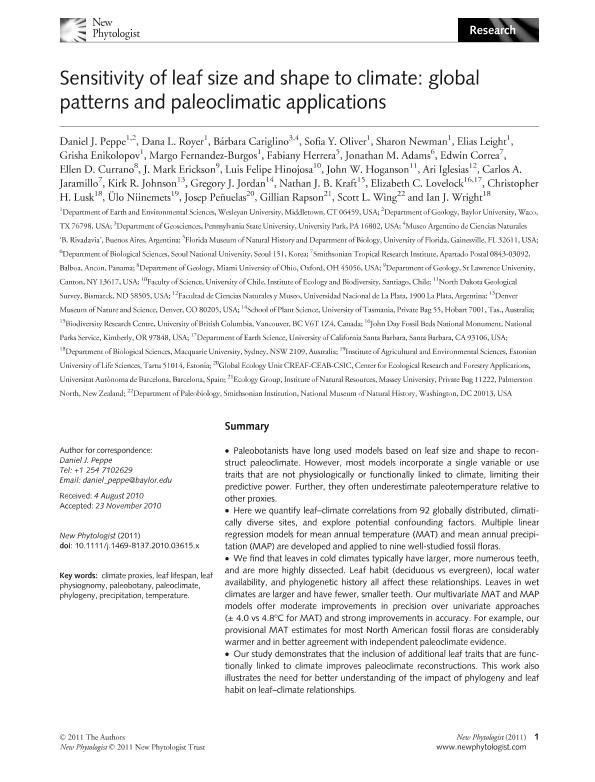Artículo
Sensitivity of leaf size and shape to climate: Global patterns and paleoclimatic applications
Peppe, Daniel J.; Royer, Dana L.; Cariglino, Barbara ; Oliver, Sofia Y.; Newman, Sharon; Leight, Elias; Enikolopov, Grisha; Fernandez-Burgos, Margo; Herrera, Fabiany; Adams, Jonathan M.; Correa, Edwin; Currano, Ellen D.; Erickson, J. Mark; Hinojosa, Luis Felipe; Hoganson, John W.; Iglesias, Ari
; Oliver, Sofia Y.; Newman, Sharon; Leight, Elias; Enikolopov, Grisha; Fernandez-Burgos, Margo; Herrera, Fabiany; Adams, Jonathan M.; Correa, Edwin; Currano, Ellen D.; Erickson, J. Mark; Hinojosa, Luis Felipe; Hoganson, John W.; Iglesias, Ari ; Jaramillo, Carlos A.; Johnson, Kirk R.; Jordan, Gregory J.; Kraft, Nathan J. B.; Lovelock, Elizabeth C.; Lusk, Christopher H.; Niinemets, Ülo; Peñuelas, Josep; Rapson, Gillian; Wing, Scott L.; Wright, Ian J.
; Jaramillo, Carlos A.; Johnson, Kirk R.; Jordan, Gregory J.; Kraft, Nathan J. B.; Lovelock, Elizabeth C.; Lusk, Christopher H.; Niinemets, Ülo; Peñuelas, Josep; Rapson, Gillian; Wing, Scott L.; Wright, Ian J.
 ; Oliver, Sofia Y.; Newman, Sharon; Leight, Elias; Enikolopov, Grisha; Fernandez-Burgos, Margo; Herrera, Fabiany; Adams, Jonathan M.; Correa, Edwin; Currano, Ellen D.; Erickson, J. Mark; Hinojosa, Luis Felipe; Hoganson, John W.; Iglesias, Ari
; Oliver, Sofia Y.; Newman, Sharon; Leight, Elias; Enikolopov, Grisha; Fernandez-Burgos, Margo; Herrera, Fabiany; Adams, Jonathan M.; Correa, Edwin; Currano, Ellen D.; Erickson, J. Mark; Hinojosa, Luis Felipe; Hoganson, John W.; Iglesias, Ari ; Jaramillo, Carlos A.; Johnson, Kirk R.; Jordan, Gregory J.; Kraft, Nathan J. B.; Lovelock, Elizabeth C.; Lusk, Christopher H.; Niinemets, Ülo; Peñuelas, Josep; Rapson, Gillian; Wing, Scott L.; Wright, Ian J.
; Jaramillo, Carlos A.; Johnson, Kirk R.; Jordan, Gregory J.; Kraft, Nathan J. B.; Lovelock, Elizabeth C.; Lusk, Christopher H.; Niinemets, Ülo; Peñuelas, Josep; Rapson, Gillian; Wing, Scott L.; Wright, Ian J.
Fecha de publicación:
05/2011
Editorial:
Wiley Blackwell Publishing, Inc
Revista:
New Phytologist
ISSN:
0028-646X
Idioma:
Inglés
Tipo de recurso:
Artículo publicado
Clasificación temática:
Resumen
Paleobotanists have long used models based on leaf size and shape to reconstruct paleoclimate. However, most models incorporate a single variable or use traits that are not physiologically or functionally linked to climate, limiting their predictive power. Further, they often underestimate paleotemperature relative to other proxies. Here we quantify leaf-climate correlations from 92 globally distributed, climatically diverse sites, and explore potential confounding factors. Multiple linear regression models for mean annual temperature (MAT) and mean annual precipitation (MAP) are developed and applied to nine well-studied fossil floras. We find that leaves in cold climates typically have larger, more numerous teeth, and are more highly dissected. Leaf habit (deciduous vs evergreen), local water availability, and phylogenetic history all affect these relationships. Leaves in wet climates are larger and have fewer, smaller teeth. Our multivariate MAT and MAP models offer moderate improvements in precision over univariate approaches (±4.0 vs 4.8°C for MAT) and strong improvements in accuracy. For example, our provisional MAT estimates for most North American fossil floras are considerably warmer and in better agreement with independent paleoclimate evidence. Our study demonstrates that the inclusion of additional leaf traits that are functionally linked to climate improves paleoclimate reconstructions. This work also illustrates the need for better understanding of the impact of phylogeny and leaf habit on leaf-climate relationships.
Archivos asociados
Licencia
Identificadores
Colecciones
Articulos(CCT - LA PLATA)
Articulos de CTRO.CIENTIFICO TECNOL.CONICET - LA PLATA
Articulos de CTRO.CIENTIFICO TECNOL.CONICET - LA PLATA
Articulos(MACNBR)
Articulos de MUSEO ARG.DE CS.NAT "BERNARDINO RIVADAVIA"
Articulos de MUSEO ARG.DE CS.NAT "BERNARDINO RIVADAVIA"
Citación
Peppe, Daniel J.; Royer, Dana L.; Cariglino, Barbara; Oliver, Sofia Y.; Newman, Sharon; et al.; Sensitivity of leaf size and shape to climate: Global patterns and paleoclimatic applications; Wiley Blackwell Publishing, Inc; New Phytologist; 190; 3; 5-2011; 724-739
Compartir
Altmétricas



